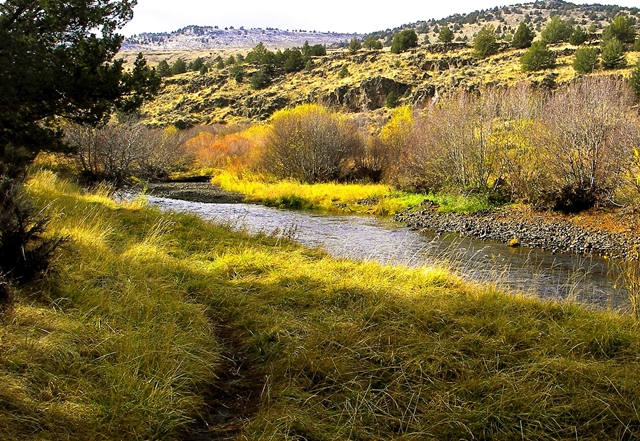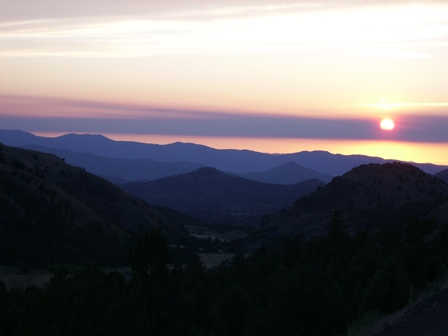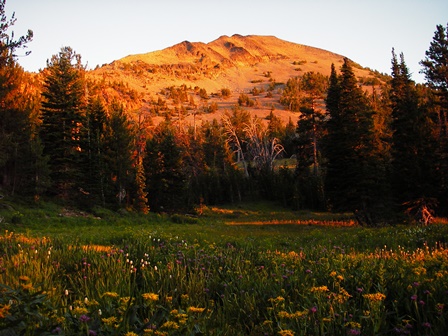
By Pam Hardy, Central Oregon Field Coordinator
The Forest Service has come up with a new idea on how to do NEPA. It’s got me worried. At its best it would mean streamlining environmental review, and getting projects we like on the ground faster. At worst, it cuts out public involvement, makes adaptation to new science almost impossible, and sends proceeds that could be used for restoration and jobs out of the area.
 NEPA is the National Environmental Policy Act. It says that when the US Government wants to take action on public lands it has to take a “hard look” at the environmental consequences and document them in an Environmental Impact Statement. It’s one of the most important laws wildlands defenders like Oregon Wild have to ensure that timber sales, grazing permits, mining operations, etc. aren’t destroying our public lands.
NEPA is the National Environmental Policy Act. It says that when the US Government wants to take action on public lands it has to take a “hard look” at the environmental consequences and document them in an Environmental Impact Statement. It’s one of the most important laws wildlands defenders like Oregon Wild have to ensure that timber sales, grazing permits, mining operations, etc. aren’t destroying our public lands.
Historically, NEPA has worked on a project-by-project basis. Every timber sale, riparian restoration project, or grazing allotment has its own analysis. Part of that analysis is an opportunity for the public to provide supplemental science and feedback to the government. Even better, the federal agency is actually required to read those comments and respond to them.
Under the new vision of NEPA being considered by the Forest Service, this important analysis wouldn’t occur on a project-by-project basis. Instead, the agency would lump together many projects that they consider similar and do the analysis all at once. For example, in Arizona in the Coronado National Forest, the Forest Service did a forest-wide analysis on planting native vegetation that would support both traditional Native American uses and pollinator species. The project generated very little controversy. After all, who would oppose retuning native plants that have been excluded from the ecosystem? Here in Oregon on the Malheur National Forest, they did a similar project analyzing certain types of riparian restoration techniques. The idea is that when the Malheur analyzes a whole watershed for a timber sale, they can easily dedicate resources to riparian restoration using the income from the timber sale.
Unfortunately, not all projects that would be streamlined by this process are as non-controversial as these. A new proposal to analyze cutting timber in dry forests on over a million acres across the Wallowa Whitman, Umatilla, Malheur and Ochoco National Forests raises serious red flags. According to verbal assurances, the logging would be for restoration purposes only and adhere to principles that local stakeholders have agreed to in the past. As the Forest Service sees it, they’re only going after the non-controversial timber.
But there are reasons for skepticism.
What’s wrong with this picture?
It’s true that stakeholder groups, including conservation organizations like Oregon Wild, have signed on to some timber sales because we believed they were designed to be ecologically restorative. We came to that conclusion by getting out on the ground, looking at the particular situation, the science on healthy ecosystems, and carefully analyzing the proposed activities. Most importantly, each agreement came with a HUGE caveat: We signed on to projects that were small enough to be carefully analyzed before hand, and monitored after.

Monitoring is key. Logging based on ecological restoration look like a good idea in principle. It’s clear that a lot of our forests are not in a natural state because they’re either recovering from past clear cuts or have had fire suppressed for decades, or both. Science shows that eastside forests have had fires – some small ground fires, some large and intense – race through them approximately every 16 years.
How do you recover from an unnatural state? Our best guess is to thin small trees out of the forest that would have been taken by fire, and use prescribed burns to restart more natural processes. This is a good guess based on good science. But we’ve only been at this for about a decade now, and we’re pretty sure that not all the results are in.
After all, we were once certain that best management practices meant suppressing all fires in all ecosystems all the time. We were wrong then, and it is possible that we could be wrong now.
Which brings us back to the Forest Service plan to push the big “dry forest” project on the Wallowa Whitman, Umatilla, Malheur and Ochoco forests as quickly as possible because even logging for ecological restoration can bring in money and send profitable logs to local timber mills. But there are good reasons to take a step back, slow down, and take a proper hard look at what’s proposed here. A few key issues emerge:
1. If an analysis covering logging in all the dry pine forests across over a million acres is completed to cover a period of activities lasting 10 years, there is no way to ensure that the Forest Service adapts to new science. Some forest districts will voluntarily pick up the new science, but pressure to use the existing NEPA will likely be intense, especially if new science would result in less logging and generated income.
2. Doing one NEPA analysis covering so much area and time means the public, including environmental groups like Oregon Wild, will only have one formal chance to weigh in on all the proposed logging and other projects – up front. As more site-specific projects are developed down the line, there won’t be any legal opportunity to stop a poorly conceived project or insist on the inclusion of new science affecting an area.
3. Restoration thinning often results in income to the Forest Service. That income can be used in two ways:
- If the project is designed as a “stewardship project” the income can be used to complete less commercially viable restoration projects like enhancing riparian areas and aspen stands.
- If the timber sale is not done as a “stewardship project”, the money generated from logging goes to the general fund of the United States. In short, it leaves the district.
Stewardship projects not only mean more habitat for elk, deer, birds, and salmon, but also more jobs for local forest contractors. If timber sales are implemented under this new system without a holistic look at local needs, we’ll see a lot of value leave the area.
 Not surprisingly, I have been assured by the Forest Service that my fears are unfounded, and that none of these concerns will come to pass. But I worry about the fact that it would all be perfectly legal, that there would be little if any opportunity for meaningful public input, and there would be plenty of political pressure to log more when there’s no one watching.
Not surprisingly, I have been assured by the Forest Service that my fears are unfounded, and that none of these concerns will come to pass. But I worry about the fact that it would all be perfectly legal, that there would be little if any opportunity for meaningful public input, and there would be plenty of political pressure to log more when there’s no one watching.
Perhaps the biggest worry about this reinvention of NEPA? The push for even bigger and worse reforms than what I’ve covered here. We’ve seen misinformation about the value and importance of NEPA spreading, and leading to proposed reforms that would significantly reduce public oversight and participation as well as the quality and rigor of the scientific analysis required by NEPA – from Senator Wyden’s O&C Lands bill, to Governor Kitzhaber’s draft recommendations to “renew” management of our National Forests. Such threats to such a foundational environmental law cannot be ignored.
Ochoco Mountains by Andrew Newcomb;
Twin Springs Basin on the Malhheur National Forest by Charles Reneau;
Wallaowa River on the Umatilla National Forest by Pete Springer

